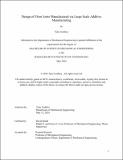Design of Floor Joists Manufactured via Large Scale Additive Manufacturing
Author(s)
Godfrey, Tyler
DownloadThesis PDF (26.30Mb)
Advisor
Hardt, David
Terms of use
Metadata
Show full item recordAbstract
There are 1.6 billion people in the world that lack adequate housing. An enormous amount of plastic is produced in the world; most of it doesn’t get recycled. The MIT HAUS group is looking to solve both of those issues by 3D printing homes out of recycled plastic. The group has printed foundation components using thermoplastic composites. The HAUS group is working from the ground up, so following the foundation would be a floor. This thesis specifically looks at the design of floor joists, the beams under the floor supporting the floor. In trying to build homes for those that lack adequate shelter, the MIT HAUS group has to design to minimize cost. The design of the floor joists seeks to minimize cost by designing a thin joist. These thin designs minimize both weight and production time. The floor joists are trusses, with different designs varying different parameters, such as the number of triangles in the beam. The designs were put through FEA simulation and small scale testing to determine the best design. Lastly, full large scale trusses for the selected design were printed on a BAAM by Additive Engineering Solutions and tested under typical floor loading conditions. Both simulation and test were in good agreement and the mid-span deflection was found to be well within accepted building standards. Key Words: 3D Printing, Floor Joists, Truss, Recycled Plastic
Date issued
2024-05Department
Massachusetts Institute of Technology. Department of Mechanical EngineeringPublisher
Massachusetts Institute of Technology